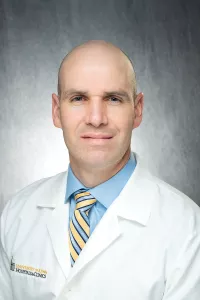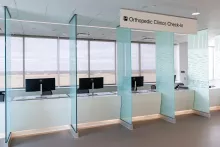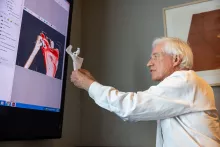Shoulder Replacement
- For all other requests:
- 1-800-777-8442
If you have shoulder joint damage and pain from arthritis, a rotator cuff tear, a shoulder fracture, or another condition, shoulder replacement surgery (arthroplasty) could bring you relief.
Our University of Iowa Health Care orthopedics team includes some of Iowa's top shoulder surgeons. UI Health Care is one of the highest-volume shoulder replacement centers in Iowa, performing more than 300 shoulder replacements per year.
Whether your shoulder condition is straightforward or complex, our surgeons can fix it. They use their years of experience, plus the latest surgical technology and techniques, to create a personalized treatment plan for you.
When you choose an expert surgeon, shoulder replacement surgery can get you back to an active, pain-free life.
The UI Health Care approach to shoulder replacement
UI Health Care orthopedic surgeons have performed shoulder replacement surgery for decades.
They've always been on the leading edge of advancements that make surgery easier on you and result in better, longer-lasting outcomes.
Shoulder replacement surgery replaces the ball and/or socket in your shoulder joint with metal and plastic implants.
UI Health Care surgeons use imaging and special software to plan your surgery from start to finish before you ever enter the operating room.
In fact, they're helping to develop and refine software that turns CT or MRI images into a 3D image of your unique anatomy.
Your surgeon will use the software to look inside your shoulder. They can order custom implants designed for your body if you need them. They'll also see the exact placement of the implants in real time during your surgery.
This approach ensures precise placement of your implant for the best results.
Our surgeons are some of the only providers in Iowa who routinely use this advanced tool.
From your very first visit, the UI Health Care team strives to make your shoulder replacement experience comfortable and efficient.
For your convenience, we'll coordinate your initial imaging and evaluation appointments to take place on a single day.
We work to schedule your surgery quickly. Afterward, our team of physical therapy experts will help you through your recovery so you can get back to normal activity as soon as possible.
Types of shoulder replacement surgery
UI Health Care surgeons offer all three types of shoulder replacement surgery available.
Anatomic total shoulder replacement replaces both the ball and socket of your shoulder joint. The socket is attached to your shoulder blade and the ball is attached to your upper arm bone. This mimics the natural shape of your bones.
Reverse total shoulder replacement also replaces both the ball and socket, but the ball is attached to your shoulder blade and the socket is attached to your arm bone. This approach is used if you have severe damage to the muscles and tendons (rotator cuff) that keep your ball and socket in place.
Partial replacement (hemiarthroplasty) replaces only the ball of your shoulder joint. It's used if the ball is damaged, but the socket is healthy.
What to expect from your shoulder replacement
Shoulder replacement surgery is performed in the hospital while you're asleep under general anesthesia.
Most shoulder replacement procedures take two to three hours, but it could take longer if you have a complex shoulder problem.
UI Health Care offers outpatient shoulder replacement, which means you could potentially leave the hospital on the same day as your surgery. Alternatively, some patients may stay in the hospital one to two nights after the procedure. We partner with our anesthesia team to ensure your pain is well controlled when you go home after surgery.
After your surgery
- A physical therapist will work with you in the hospital after your surgery. This starts your process of getting back to normal movement right away. You'll get instructions for continuing your exercises at home.
- You'll go home with your arm in a sling to limit your shoulder movement while you heal. You'll wear it for two to six weeks, depending on the surgery performed. But you can take it off to bathe, do your physical therapy exercises, and perform many other simple tasks with your arm and hand.
- Two weeks after surgery, you'll also begin seeing a physical therapist for additional exercises. These visits will continue for six to eight weeks.
- Ten to 14 days after your surgery, you may see your surgeon for a follow-up visit to check your progress. You'll have another visit about a month after that. Then you’ll continue to see your surgeon as needed to ensure you are on the right track and achieving appropriate improvements.
- You should be able to drive and return to light work activities after four to six weeks.
Can you benefit from shoulder replacement?
Your surgeon may suggest shoulder replacement if you have:
- A previous shoulder replacement that was not successful
- Avascular necrosis (death of bone tissue)
- Osteoarthritis (degenerative joint disease)
- Post-traumatic arthritis
- Rheumatoid arthritis
- Shoulder fracture
- Tried nonsurgical treatments that haven't worked, such as anti-inflammatories, cortisone injections, or physical therapy
- A poorly functioning or torn rotator cuff
- A nerve injury
- An active shoulder infection
- Severe loss of bone on the ball or socket of your shoulder joint
Your provider will work with you on other ways to manage your condition. These might include:
- Applying heat or ice
- Arthroscopy to remove tissue or cartilage or to repair a ligament
- Injections of cortisone
- Pain medication
- Physical therapy to stretch and strengthen your shoulder muscles and help reduce your pain and stiffness
Our Care Team



Need a shoulder replacement expert?
Locations and Offices



Patient Stories

Related News
